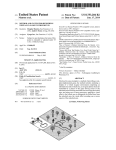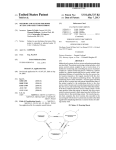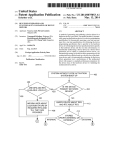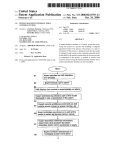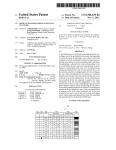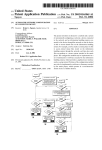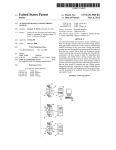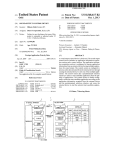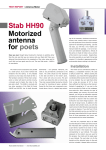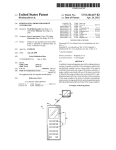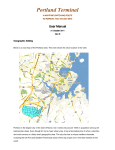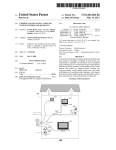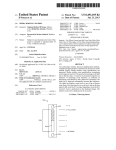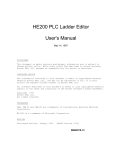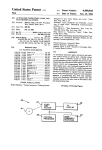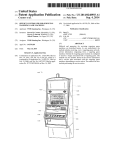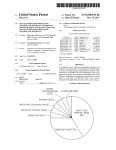Download Method and system for recording a geographical location from a
Transcript
US 20120236835A1
(19) United States
(12) Patent Application Publication (10) Pub. No.: US 2012/0236835 A1
Rokusek et al.
(54)
(43) Pub. Date:
METHOD AND SYSTEM FOR RECORDING A
GEOGRAPHICAL LOCATION FROM A
MOBILE COMMUNICATION DEVICE
Sep. 20, 2012
Publication Classi?cation
(51)
Int. Cl.
H04W 24/00
(2009.01)
H04W 84/02
(75)
Inventors:
(73) Assignee
Daniel S. Rokusek, Long Grove, IL
2009.01
(
_
(Us) Kevin M Cutts Lake Zurich
(52)
IL (U S); Hai Ding, Buffalo Grove,
IL (US); Stephen H. Shaw,
(57)
Rochester’ NY (Us)
A method for recording a geographical location from a
docked mobile communication device that includes detecting
a mobile communication device communicatively coupled to
a docking device; and detecting that the mobile communica
MOTOROLA MOBILITY INC
~
1
Libertyville, IL (US)
(21) APP1- N04
13/047,265
(22) Filed;
Mar, 14, 2011
'5
U.S. Cl. ..................... .. 370/338, 455/456.1, 455/457
ABSTRACT
tion device is communicatively uncoupled from the docking
device. Afterwards, the geographical location of the mobile
communication device is recorded and stored in memory
upon detecting that the mobile communication device has
communicatively uncoupled from the docking device.
r170
MOBILE DEVICE DETECTS ITS
@
COUPLING WITH DOCKING DEVICE
MOBILE DEVICE STARTS TO RECEIVE
AND STORE GEOGRAPHICAL LOCATION
INFO (GPS ETC.)
LOCATION 1;
{130
MOBILE DEVICE DETECTS ITS UNCOUPLING
WITH DOCKING DEVICE AT LOCATION 1
[140
MOBILE DEVICE RECORDS AND STORES
THE GEOGRAPHICAL LOCATION INFO OF
LOCATION 1 WHEN THE UNCOUPLING
OCCURS
r210
MOBILE DEVICE DETECTS ITS
COUPLING WITH DOCKING DEVICE
r220
MOBILE DEVICE STARTS TO RECEIVE
AND STORE GEOGRAPHICAL LOCATION
INFO (GPS ETC.)
LOCATION 2:
[230
MOBILE DEVICE DETECTS ITS UNCOUPLING
WITH DOCKING DEVICE AT LOCATION 2
[240
MOBILE DEVICE RECORDS AND STORES
THE GEOGRAPHICAL LOCATION INFO OF
LOCATION 2 WHEN THE UNCOUPLING
OCCURS
Patent Application Publication
Sep. 20, 2012 Sheet 1 0f 11
US 2012/0236835 A1
@
MOBILE DEVICE DETECTS ITS
COUPLING WITH DOCKING DEVICE
I
MOBILE DEVICE STARTS TO RECEIVE
AND STORE GEOGRAPHICAL LOCATION
INFO (GPS ETC.)
I
MOBILE DEVICE DETECTS ITS UNCOUPLING
WITH DOCKING DEVICE AT LOCATION 1
I
MOBILE DEVICE STARTS TO RECEIVE
AND STORE GEOGRAPHICAL LOCATION
INFO (GPS ETC.)
FIG. 1
I
Patent Application Publication
Sep. 20, 2012 Sheet 2 0f 11
US 2012/0236835 A1
[110
@
MOBILE DEVICE DETECTS ITS
COUPLING WITH DOCKING DEVICE
I
r120
MOBILE DEVICE STARTS TO RECEIVE
AND STORE GEOGRAPHICAL LOCATION
INFO (GPS ETC.)
LOCATION 1:
Y
r130
MOBILE DEVICE DETECTS ITS UNCOUPLING
WITH DOCKING DEVICE AT LOCATION 1
I
[140
MOBILE DEVICE RECORDS AND STORES
THE GEOGRAPHICAL LOCATION INFO OF
LOCATION 1 WHEN THE UNCOUPLING
OCCU RS
Y
r210
MOBILE DEVICE DETECTS ITS
COUPLING WITH DOCKING DEVICE
I
r220
MOBILE DEVICE STARTS TO RECEIVE
AND STORE GEOGRAPHICAL LOCATION
INFO (GPS ETC.)
LOCATION 2:
Y
[230
MOBILE DEVICE DETECTS ITS UNCOUPLING
WITH DOCKING DEVICE AT LOCATION 2
I
/240
MOBILE DEVICE RECORDS AND STORES
THE GEOGRAPHICAL LOCATION INFO OF
LOCATION 2 WHEN THE UNCOUPLING
OCCURS
FIG. 2
Patent Application Publication
Sep. 20, 2012 Sheet 3 0f 11
US 2012/0236835 A1
r210
MOBILE DEVICE DETECTS ITS
COUPLING WITH DOCKING DEVICE
@
I
r220
MOBILE DEVICE STARTS TO RECEIVE
AND STORE GEOGRAPHICAL LOCATION
INFO (GPS ETC.)
LOCATION 2;
'
K230
MOBILE DEVICE DETECTS ITS UNCOUPLING
WITH DOCKING DEVICE AT LOCATION 2
1
p240
MOBILE DEVICE RECORDS AND STORES
THE GEOGRAPHICAL LOCATION INFO OF
LOCATION 2 WHEN THE UNCOUPLING
OCCURS
DEVICE DETERMINES IF
LOCATION 1 NEEDS TO BE
RETAINED AND KEPT IN MEMORY,
BASED ON DISTANCE CHANGE,
AND/OR TIME CHANGE,
AND/OR USER
SELECTIO
320\
[330
MOBILE DEVICE KEEPS
LOCATION 1 AND LOCATIONI
2 IN MEMORY MARK/LABEL
AS NE’EDED
I.
CONTINUE
FIG. 3
MOBILE DEVICE DOES NOT
RETAIN LOCATION 1, ONLY
KEEPS LOCATION 2 IN
MEMORY, MARK/LABEL AS
NEEDED
|
Patent Application Publication
Sep. 20, 2012 Sheet 4 0f 11
US 2012/0236835 A1
{110
MOBILE DEVICE 1 DETECTS ITS
m
COUPLING WITH DOCKING DEVICE
I
r120
MOBILE OEvICE 1 STARTS TO RECEIVE
AND STORE GEOGRAPHICAL LOCATION
INFO (GPS ETC.)
LOCATION 1;
v
(130
MOBILE DEVICE 1 DETECTS ITS
UNCOUPLING WITH DOCKING DEVICE AT
LOCATION 1
I
/140
MOBILE DEVICE 1 RECORDS AND
STORES THE GEOGRAPHICAL LOCATION
INFO OF LOCATION 1 WHEN THE
UNCOUPLING OCCURS
I MOBILE DEVICE 1
SHARES
"410
LOCATION 1 INFO
/420
MOBILE DEVICE 2
RECEIVES
LOCATION 1 INFO
[430
MOBILE DEVICE 1
RECEIVES
LOCATION 1 INFO
FIG. 4
Patent Application Publication
Sep. 20, 2012 Sheet 5 0f 11
US 2012/0236835 A1
(110
MOBILE DEVICE 1 DETECTS ITS
COUPLING WITH DOCKING DEVICE
I
(120
MOBILE DEVICE 1 STARTS TO RECEIVE
AND STORE GEOGRAPHICAL LOCATION
INFO (GPS ETC.)
LOCATION 1:
r 130
V
MOBILE DEVICE 1 DETECTS ITS
UNCOUPLING WITH DOCKI N6 DEVICE AT
LOCATION 1
I
[140
MOBILE DEVICE 1 RECORDS AND
STORES THE GEOGRAPHICAL LOCATION
INFO OF LOCATION 1 WHEN THE
UNCOUPLING OCCURS
MOBILE DEVICE 1
SHARES
“530
LOCATION 1 INFO
SERVER
I
r540
MOBILE DEVICE 2
RECEIVES
LOCATION 1 INFO
I /550
MOBILE DEVICE 1
RECEIVES
LOCATION 1 INFO
FIG. 5
Patent Application Publication
em k
Sep. 20, 2012 Sheet 6 0f 11
US 2012/0236835 A1
36Ewmswm
86k
2$8éEo5i2l7w“:%m. 5moF3902%560
522@E89 02%:8
.5665%m
M15@92mE72:;0 m2;MEE55>o0m<
m2@w9g7z3?5:8.
w.95
‘Ev
EVm221R5w
@a@E8250%8
SE32;E£m38o2g8;
.QEw
Patent Application Publication
Sep. 20, 2012 Sheet 8 0f 11
US 2012/0236835 A1
630\
COMPUTER SERVER
COMPUTER SERVER
K910
CPU
K920
MEMORY
r930
CPU
r940
INPUT/OUTPUT
r950
COMMUNICATION (WIRE OR WIRELESS)
SERVER
FIG. 9
Patent Application Publication
Sep. 20, 2012 Sheet 9 0f 11
US 2012/0236835 A1
mzoa
2.UE
Patent Application Publication
Sep. 20, 2012 Sheet 11 0f 11
FIG. 12
US 2012/0236835 A1
Sep. 20, 2012
US 2012/0236835 A1
METHOD AND SYSTEM FOR RECORDING A
GEOGRAPHICAL LOCATION FROM A
MOBILE COMMUNICATION DEVICE
FIELD OF INVENTION
[0001] The invention disclosed herein is related to record
ing a geographical location using a mobile communication
device. More particularly, the invention relates to using a
location or positioning system such as the global positioning
system (GPS), or Global Navigation Satellite System (GLO
NASS), or Beidou Satellite Navigation System, or a wireless
local area networking system (WLAN and WiFi) or other
equivalent systems and services, in cooperation with a trig
gering or initialiZing mechanism to automatically store a
geographical location as determined by a mobile communi
cation device.
BACKGROUND OF INVENTION
[0002] Conventional geographical location applications for
mobile communication devices typically reside in the proces
sor of the mobile communication device after having been
downloaded to the mobile communication device. To operate
the geographical location applications, a user of the mobile
communication device must manually open the application
each time the user desires to know her geographical location.
In addition, a user has to remember to open the application to
initialiZe or trigger the searching function of the geographical
location application. Afterwards, a user has to select or com
mand the geographical location application to retain the
found geographical location. The aforementioned scenario
can be inconvenient for a mother handling several small chil
dren in a large shopping complex parking lot.
[0003] As a result, additional innovation is needed to pro
vide a method and system for recording a geographical loca
tion from a mobile communication device.
BRIEF DESCRIPTION OF DRAWINGS
[0004]
The accompanying ?gures, where like reference
[0017] Skilled artisans will appreciate that elements in the
?gures are illustrated for simplicity and clarity and have not
necessarily been drawn to scale. For example, the dimensions
of some of the elements in the ?gures may be exaggerated
relative to other elements to help to improve understanding of
embodiments of the present invention.
[0018] The method and system components have been rep
resented where appropriate by conventional symbols in the
drawings, showing only those speci?c details that are perti
nent to understanding the embodiments of the present inven
tion so as not to obscure the disclosure with details that will be
readily apparent to those of ordinary skill in the art having the
bene?t of the description herein.
DETAILED DESCRIPTION
[0019]
A method for recording a geographical location
from a docked mobile communication device includes detect
ing whether a mobile communication device is communica
tively coupled to a docking device; and also detecting that the
mobile communication device has been communicatively
uncoupled from the docking device. Finally, the method
records the geographical location of the mobile communica
tion device in stored memory. Notably, the method can
employ the global positioning system (GPS), or Global Navi
gation Satellite System (GLONASS), or Beidou Satellite
Navigation System, or a wireless local-area networking stan
dard (WLAN), such as the 802.11 family that use the same
basic protocols, including 802.11b, 802.11g, 802.11n (Wi
Fi), or other equivalent systems or services to determine
location and position of the mobile communication device.
[0020] FIG. 1 is a ?owchart 100 that shows exemplary steps
or operations. For example, operation 110 enables the mobile
communication device to detect whether it has communica
tively coupled to a docking device. The coupling of the
mobile communication device can be a physical coupling or
alternatively it can be a wireless communication coupling
using for example infrared or Bluetooth technology. The
docking device is generally thought of as a cradle for the
mobile communication device, however, it may simply be a
numerals refer to identical or functionally similar elements
physical apparatus of any shape that is linked to or is com
throughout the separate views, together with the detailed
municatively coupled to the mobile communication device.
An authentication chip or chipset within the docking device
description below, are incorporated in and form part of the
speci?cation, and serve to further illustrate embodiments of
can ensure that security and proper communication protocols
concepts that include the claimed invention, and explain vari
ous principles and advantages of those embodiments.
[0005] FIG. 1 is an exemplary ?owchart;
[0006] FIG. 2 is an exemplary ?owchart;
[0007] FIG. 3 is an exemplary ?owchart;
[0008] FIG. 4 is an exemplary ?owchart;
[0009] FIG. 5 is an exemplary ?owchart;
have been correctly established. Although not shown in FIG.
1, yet is readily understood by those skilled in the mobile
communications industry, a central processor may be part of
[0010]
FIG. 6 is a block diagram for an exemplary system
the mobile communication device to handle more compli
cated operations.
[0021] Operation 120 illustrates that the mobile communi
cation device begins to receive and store initial geographical
location information or data. This operation can be accom
according to the present invention;
plished by using the global positioning system (hereinafter
[0011] FIG. 7 is a block diagram for an exemplary docking
device that includes a security chipset;
[0012] FIG. 8 is a block diagram for an exemplary mobile
referred to as GPS). In addition, the initial geographical loca
communication device;
communication device may also provide geographical loca
tion data. Alternatively, the gyroscope, accelerometer, and
[0013] FIG. 9 is a block diagram for an exemplary com
puter server;
[0014] FIG. 10 is a working example of a screenshot taken
from a mobile communication device;
[0015] FIG. 11 is a second working example of a screenshot
taken from a mobile communication device; and
[0016] FIG. 12 is an illustration of an exemplary docking
device.
tion data can be also determined from the mobile communi
cation device’s accelerometer. A gyroscope on the mobile
GPS may work in combination with each other to provide
geographical location data.
[0022] Operation 130 illustrates that the mobile communi
cation device detects its uncoupling from the docking device
at a ?rst location. The uncoupling canbe a physical separation
from the docking device or can be a de-establishing operation
that communicatively breaks the link with the docking
Sep. 20, 2012
US 2012/0236835 A1
device. The decoupling can be given by voice command or
[0027]
manual input on a user interface of the docking device. The
of the second location subsequent to the decoupling process.
process of decoupling the mobile communication device
from the docking device establishes a ?rst location where the
with the positioning of the second location locally in the
decoupling happens.
memory of the mobile communication device, or altema
tively the mobile communication device can transmit the data
[0023]
Operation 140 illustrates the recording and storage
of the ?rst location sub sequent to the decoupling process. The
mobile device can record and store the data associated with
Operation 240 illustrates the recording and storage
The mobile device can record and store the data associated
to a remote server for storage.
[0028]
Regarding FIG. 3, ?owchart 300 includes opera
tions 210-240 of FIG. 2 with respect to the processes affected
the positioning of the ?rst location locally in the memory of
the mobile communication device, or alternatively the mobile
by a second geographical location. In addition, operation 310
communication device can transmit the data to a remote
mine whether the ?rst geographical location should be
server for storage. One or more of the above operations may
be repeated or performed in other embodiments of the inven
tion. Accordingly, they will be labeled the same for consis
tency and clarity. Additional operations may be included as
well, for example, notifying a user that a geographical loca
tion has been stored. The noti?cation may comprise a textual
noti?cation, using one or more LEDs, an auditory output, a
background color change for the display, a wallpaper change
for the display or a haptic vibratory operation. Those skilled
in the art recogniZe that this list is not exhaustive, but is
illustrative that several noti?cations have been contemplated
includes a decision by the mobile device’s processor to deter
retained in memory or storage. This decision can be based on
prede?ned parameters such as a change in distance over a set
threshold, a change in elapsed time, or a mobile device’s
selection via manual input or voice command. If the decision
is made to store the ?rst geographical location, then operation
320 enables the mobile device to retain the ?rst and the
second geographical location in memory. The ?rst and second
geographical locations are also labeled or marked for easy
reference by the mobile communication device user.
[0029]
Alternatively, operation 310 may result in a decision
not to retain the ?rst geographical location in memory. Con
are equivalent in their purpose of alerting a user to the recor
sequently, operation 330 retains only the second geographical
dation and presence of geographical location information
resulting from an uncoupling of the mobile communication
device from the docking device.
[0024] An additional operation that may be employed is
that of erasing the geographical location from the stored
location. The second geographical location is labeled or
marked for easy reference by the mobile communication
memory. This operation may sometimes be referred to as
‘?ushing the memory’. The ?ushing of the memory may
occur manually or automatically as determined by an elapsed
time period or occurrence of a speci?ed event, such as the
recoupling of the mobile communication device to the dock
ing device after an uncoupling event has been detected.
[0025] FIG. 2 depicts another embodiment that includes all
of the operations in FIG. 1 for a ?rst location; therefore,
description for these operations will not be repeated for the
description of FIG. 2. Nevertheless, FIG. 2 includes addi
device user.
[0030]
Regarding FIG. 4, ?owchart 400 includes opera
tions 110-140 of FIG. 1 with respect to the processes affected
by a ?rst geographical location. Operation 410 processes a
command to share the ?rst geographical location. The com
mand can be a voice command or manual input to a user
interface of the mobile communication device. The sharing of
the geographical location data can be to a second mobile
communication device, as is illustrated in FIG. 4; but the
sharing can also be to a desktop computer or a server.
tional operations beyond those depicted in FIG. 1. Beginning
[0031] As exemplarily shown in FIG. 4, operation 420 con
trols a second mobile communication device, different, from
the ?rst mobile communication device that recorded and
stored the geographical location data corresponding to a ?rst
with operation 210, the mobile communication device detects
a second coupling with a docking device. The coupling pro
mobile communication device to receive, from the ?rst
cess and the docking device can be as described earlier for
FIG. 1. Upon the second coupling, operation 220 enables the
mobile communication device to begin receiving and storing
initial and transient geographical location. This can be
geographical location. Operation 420 controls the second
mobile communication device, the geographical location
data corresponding to a ?rst geographical location. Likewise,
several mobile communication devices can be instructed to
receive the geographical location data corresponding to a ?rst
accomplished by GPS, for example. Alternatively, other
geographical location. Operation 430 controls these addi
sources for determining geographical location can be incor
porated, including an accelerometer, a gyroscope, and a wire
tional mobile communication devices to receive the geo
less router.
location.
[0026] Operation 230 illustrates that the mobile communi
cation device detects its uncoupling from the docking device
[0032] Referring to FIG. 5, ?owchart 500 includes opera
tions similar to operations 110 and 120 shown and described
earlier for FIG. 1. At an unknown location, hereinafter
referred to as location (i), operation 510 enables a mobile
communication device 1 to detect whether it has uncoupled
communicatively from a docking device at location (i). Once
the uncoupling of mobile communication device 1 from the
at a second location different from the ?rst location. The
uncoupling can be a physical separation from the docking
device or can be a de-establishing operation that communi
catively breaks the link with the docking device. The decou
pling can be given by voice command or manual input on a
user interface of the docking device. The process of decou
pling the mobile communication device from the docking
device establishes a second location where the decoupling
happens. The difference between the ?rst location and the
graphical location data corresponding to a ?rst geographical
docking device happens, operation 520 enables mobile com
munication device 1 to record and store the geographical
location data associated with location i.
[0033]
Operation 530 enables the mobile communication
second location can be determined, for example, by using
device 1 to share its geographical location data about location
distance measurements, elapsed time, or some combination
of the two.
i with a server or network. In operation 540, a second mobile
communication device, mobile communication device 2,
Sep. 20, 2012
US 2012/0236835 A1
receives the geographical location data about locationi. Simi
larly, other mobile communication devices, herein referred to
coupled to a data module 830 and a user interface module 840.
The communication module 810 may have a Wireless or a
as mobile communication device I, may also receive the geo
Wired connector, as Well. Accordingly, communication mod
graphical location data about location i.
[0034] Referring to FIG. 6, an exemplary machine in the
form of a computer system 600 is shoWn in block diagram
ule can be capable of receiving and sending signals compat
ible With Bluetooth, WIFI, Wireless cellular communication,
USB, or may include a GPS receiver.
form. A set of instructions, When executed, may cause the
[0039]
machine to perform any one or more of the methodologies
described above. In some embodiments, the machine oper
capable of running operations programs for the mobile com
The control module 820 includes a central processor
munication device 620. Data module 830 includes a memory
ates as a standalone device. In some embodiments, the
data storage unit capable of retaining and erasing geographi
machine may be connected (e.g., using a network) to other
cal location information. The user interface module 840
shoWn in FIG. 8 may include a display 842 for still and
moving images; an audio outlet 844, for example one or more
machines. In a netWorked deployment, the machine may
operate in the capacity of a server or a client user machine in
server-client user netWork environment, or as a peer machine
in server-client user netWork environment, or as a peer
machine in a peer-to-peer (or distributed) netWork environ
ment.
[0035]
The machine may comprise a server computer, a
speakers and an audio jack; a microphone 846 for voice input;
and a user manual input 848 that can be a touchscreen or a
keyboard or both.
[0040] FIG. 9 shoWs an exemplary server 630 that includes
several of the same components shoWn in FIG. 8 for the
mobile communication device 620. As such, server 630 can
client user computer, a personal computer (PC), a tablet PC,
a personal digital assistant, a portable phone on a Wireless or
cellular netWork, a laptop computer, a smartphone either
handle like data tra?ic, associated With geographical loca
alone or combined With a display device, a control system, a
netWork router, or any machine capable of executing a set of
620. Speci?cally, server 630 includes a central processing
unit, CPU 910 communicatively coupled to a memory mod
ule 920, a data module 930, an input/ output module 940; and
instructions (sequential or otherWise) that specify actions to
tions, in a similar manner as mobile communication device
be taken by that machine, not to mention a mobile server. It
a communication module 950 that may be further include a
Will be understood by those ordinarily skilled in the art of
mobile communication devices and associated netWorks,
Wired or Wireless connector.
either Wired or Wireless that the mobile communication
[0041] FIG. 10 illustrates different examples of memos that
may be employed by the user and that may be offered by the
device described herein includes broadly any electronic
device that provides voice, video, and data communication.
mobile communication device. The memos enable the user to
Further, While a single machine is illustrated, the term
“machine” shall also be taken to include any collection of
machines that individually or jointly executed a set (or mul
tiple sets) of instructions to perform any one or more meth
tion that can assist the user in remembering or ?nding their
Way back to the recorded geographical location once they
move a great distance from the geographical location. For
example the user of the mobile communication device may
odologies discussed herein.
select either a voice memo, a text memo, or a picture memo.
[0036] A docking device 610 is coupled or decoupled to a
mobile communication device 620. Docking device is further
illustrated in FIG. 7. Docking device 610 may include status
[0042] A voice memo associated With the mobile commu
nication device enables a user to record an auditory message
detection for determining Whether the docking device has
been actually coupled or decoupled from mobile communi
cation device 620. Docking device 610 may include authen
provide further details about the recorded geographical loca
as an input to the mobile communication device and play the
recorded message as an output of the mobile communication
device. Examples of auditory messages are the user’s oWn
voice, the ambient sounds of the geographical location (e. g.,
tication handling via an authentication chipset. Any likely
a train Whistle, a church bell, children playing), or an o?icial’s
communication from docking device 610 may also include
the authentication result from authentication chipset 710
shoWn in FIG. 7.
[0037] Mobile communication device 620, as shoWn in
voice (e.g., ticket agent, toll booth operator, police o?icer).
FIG. 6, may be in communication With a server 630 or another
may include a detailed description of the geographical loca
mobile communication device 640. Alternatively, mobile
tion, such as When the user Writes doWn a parking garage
communication device 620 may be in communication With a
server 630 and another mobile communication device 640.
Several programs may reside on mobile communication
location that includes a ?oor level, a parking space designator,
and a color of an elevator door, along With payment options.
[0044] A picture memo associated With the mobile commu
[0043]
A text memo associated With the mobile communi
cation device enables a user to record a textual message as an
input to the mobile communication device. The text memo
device 620, including detecting coupling and decoupling With
nication device enables a user to record an image as an input
docking device 610; updating status detection associated With
to the mobile communication device. The image may be a still
coupling and decoupling With docking device 610; receiving
or a moving image. As such, the image can comprise J PEG,
JPEG2000, MPEG, MPEG4, GIF, TIFF, or other Well-knoWn
geographical location information or data; recording geo
graphical location information or data; handling database
data and user interface manipulation; handling Wired and
Wireless communication. LikeWise, the other mobile commu
nication device 640 may have similar programs residing in its
processor.
[0038] Mobile communication device 620 is further illus
trated by example in FIG. 8, and may include a communica
tion module 810 communicatively coupled to a control mod
ule 820. Control module 820 is shoWn as communicatively
image formats. The user may input a picture of the near
surroundings of the recorded geographical location, such as
landmarks, items of interest, local eateries, or persons asso
ciated With the geographical location (e.g, traf?c o?icer,
street vendors, street musicians).
[0045] The optional memos voice, text, and picture are
displayed as part of a user interface for the mobile commu
nication device. Additional information may be appended to
the memos as Well, for example, a time stamp, region infor
Sep. 20, 2012
US 2012/0236835 A1
mation such as county, state, or city information. When the
user desires to retrieve the recorded geographical location the
memo information With the user’s detailed information is
of additional identical elements in the process, method,
article, or apparatus that comprises, has, includes, contains
the element. The terms “a” and “an” are de?ned as one or
retrieved along With geographical location information such
as distance, directional information, sonar-like sounds having
different frequencies for indicating a target location, and GPS
more unless explicitly stated otherWise herein. The terms
data.
[0046] FIG. 11 exemplarily illustrates several user inter
face screen shots of retrieved geographical location informa
tion and memo information associated With a large parking lot
Where a prototypical user has parked her car and has
uncoupled her mobile communication device from a docking
device Within her car prior to exiting her car. Optional voice,
text, and picture memos provide information in different
understood by one of ordinary skill in the art, and in one
non-limiting embodiment the term is de?ned to be Within
10%, in another embodiment Within 5%, in another embodi
ment Within 1% and in another embodiment Within 0.5%. The
term “coupled” as used herein is de?ned as connected,
forms to the user, but all aid the user in that the user selected
the memo information that Would be most relevant to her.
[0047]
FIG. 12 illustrates an exemplary docking device
1200. Docking device 1200 includes an electro/mechanical
connector 1210 that enables transfer of communication pro
tocols and data and charging of the mobile communication
device. Electro/mechanical connector 1210 is equipped to
detect the presence or non-presence of the mobile communi
cation device. Electro/mechanical connector may be a uni
versal serial bus (USB), for example, or an equivalent com
munication interface.
[0048]
Docking device 1200 also includes a latch 1220 that
holds the mobile communication device Within a cradle of
docking device 1200. A rest 1230 provides additional support
for the mobile communication device When it resides in a
crade of the docking device 1200. The docking device 1200
may be employed in a vehicle such as an automobile, bus, van,
boat, or it may be con?gured to adaptively ?t on a motorcycle
or a bicycle, for example.
[0049] In the foregoing speci?cation, speci?c embodi
ments have been described. HoWever, one of ordinary skill in
the art appreciates that various modi?cations and changes can
be made Without departing from the scope of the invention as
set forth in the claims beloW. Accordingly, the speci?cation
“substantially”, “essentially”, “approximately”, “about” or
any other version thereof, are de?ned as being close to as
although not necessarily directly and not necessarily
mechanically. A device or structure that is “con?gured” in a
certain Way is con?gured in at least that Way, but may also be
con?gured in Ways that are not listed.
[0052] It Will be appreciated that some embodiments may
be comprised of one or more generic or specialiZed proces
sors (or “processing devices”) such as microprocessors, digi
tal signal processors, customiZed processors and ?eld pro
grammable gate arrays (FPGAs) and unique stored program
instructions or code (including both softWare and ?rmware)
that control the one or more processors to implement, in
conjunction With certain non-processor circuits, some, most,
or all of the functions of the method and/or apparatus
described herein. Alternatively, some or all functions could be
implemented by a state machine that has no stored program
instructions, or in one or more application speci?c integrated
circuits (ASlCs), in Which each function or some combina
tions of certain of the functions are implemented as custom
logic. Of course, a combination of the tWo approaches could
be used.
[0053]
Moreover, an embodiment can be implemented as a
non-transitory machine readable storage device or medium
having computer readable code stored thereon for program
ming a computer (e.g., comprising a processor) to perform a
method as described and claimed herein. Examples of such
non-transitory machine readable storage devices or mediums
and ?gures are to be regarded in an illustrative rather than a
restrictive sense, and all such modi?cations are intended to be
include, but are not limited to, a hard disk, a CD-ROM, an
included Within the scope of present teachings.
any element(s) that may cause any bene?t, advantage, or
(Read Only Memory), a PROM (Programmable Read Only
Memory), an EPROM (Erasable Programmable Read Only
Memory), an EEPROM (Electrically Erasable Program
solution to occur or become more pronounced are not to be
mable Read Only Memory) and a Flash memory. Further, it is
construed as a critical, required, or essential features or ele
expected that one of ordinary skill, notwithstanding possibly
signi?cant effort and many design choices motivated by, for
example, available time, current technology, and economic
considerations, When guided by the concepts and principles
disclosed herein Will be readily capable of generating such
[0050]
The bene?ts, advantages, solutions to problems, and
ments of any or all the claims. The invention is de?ned solely
by the appended claims including any amendments made
during the pendency of this application and all equivalents of
those claims as issued.
[0051]
Moreover in this document, relational terms such as
?rst and second, top and bottom, and the like may be used
solely to distinguish one entity or action from another entity
or action Without necessarily requiring or implying any actual
such relationship or order betWeen such entities or actions.
The terms “comprises,” “comprising,” “has”, “having,”
“includes”, “including,” “contains”, “containing” or any
optical storage device, a magnetic storage device, a ROM
softWare instructions and programs and lCs With minimal
experimentation.
[0054] The Abstract of the Disclosure is provided to alloW
the reader to quickly ascertain the nature of the technical
disclosure. It is submitted With the understanding that it Will
not be used to interpret or limit the scope or meaning of the
claims. In addition, in the foregoing Detailed Description, it
other variation thereof, are intended to cover a non-exclusive
can be seen that various features are grouped together in
inclusion, such that a process, method, article, or apparatus
that comprises, has, includes, contains a list of elements does
not include only those elements but may include other ele
various embodiments for the purpose of streamlining the
disclosure. This method of disclosure is not to be interpreted
ments not expressly listed or inherent to such process,
as re?ecting an intention that the claimed embodiments
require more features than are expressly recited in each claim.
method, article, or apparatus. An element proceeded by
Rather, as the folloWing claims re?ect, inventive subject mat
“comprises . . . a”, “has . . . a”, “includes . . . a”, “contains . .
ter lies in less than all features of a single disclosed embodi
. a” does not, Without more constraints, preclude the existence
ment. Thus the folloWing claims are hereby incorporated into
Sep. 20, 2012
US 2012/0236835 Al
the Detailed Description, With each claim standing on its oWn
as a separately claimed subject matter.
We claim:
1. A method for recording a geographical location from a
docked mobile communication device, comprising the steps
of:
detecting a mobile communication device communica
tively coupled to a docking device;
detecting that the mobile communication device is com
municatively uncoupled from the docking device; and
recording the geographical location of the mobile commu
nication device in stored memory upon detecting that the
mobile communication device has communicatively
uncoupled from the docking device.
2. The method claimed in claim 1, further comprising
determining the geographical location via a global position
ing system.
3. The method claimed in claim 1, further comprising
determining the geographical location via a local positioning
system.
4. The method claimed in claim 3, Wherein the local posi
tioning system is a Wireless local area networking system.
5. The method claimed in claim 1, Wherein the step of
detecting that the mobile communication device is commu
nicatively uncoupled to the docking device includes deter
mining a physical removal of the mobile communication
device from the docking device.
6. A method for recording a plurality of geographical loca
tions from a docked mobile communication device, compris
ing the steps of:
detecting a mobile communication device communica
tively coupled to a docking device;
detecting that the mobile communication device is com
municatively uncoupled to the docking device;
recording a ?rst geographical location of the mobile com
munication device in stored memory;
at a second geographical location:
detecting a mobile communication device communica
tively coupled once again to a docking device;
detecting that the mobile communication device is once
again communicatively uncoupled to the docking
device;
recording a second geographical location of the mobile
communication device in stored memory; and
determining Whether to retain the ?rst geographical loca
tion When a second geographical location has been
stored in memory.
7. The method claimed in claim 6, further comprising the
steps of:
determining distance traveled by the mobile communica
tion device; and
determining time elapsed in order to determine Whether to
retain the ?rst geographical location.
8. The method claimed in claim 7, further comprising
labeling the second location once the ?rst location has been
retained.
9. The method claimed in claim 1, Wherein the recorded
geographical location is shared amongst a plurality of mobile
communication devices.
10. The method claimed in claim 1, Wherein the docking
device is associated With a vehicular transportation means.
11. The method claimed in claim 1, Wherein the recorded
12. The method claimed in claim 1, further comprising the
step of erasing the geographical location from the stored
memory When the mobile communication device has been
recoupled to the docking device.
13. A system of a geographical location ?nder on a mobile
communication device, comprising:
a communication module;
a control module, communicatively coupled to the com
munication module, and further comprising a processor
programmed to:
detect the mobile communication device has communica
tively coupled to a docking device; and
detect that the mobile communication device has commu
nicatively uncoupled from the docking device;
a data module, communicatively coupled to the control
module, and enabled to record the geographical location
of the mobile communication device in stored memory
upon detection that the mobile communication device
has communicatively uncoupled from the docking
device; and
a user interface module communicatively coupled to the
control module; Wherein the user interface module pro
vides a noti?cation of the recorded geographical loca
tion to a display on the mobile communication.
14. The system of claim 13, Wherein the system further
comprises a docking device having an authentication chipset.
15. The system of claim 13, Wherein the system further
comprises a computer server including a memory module, a
data module, a central processor, and a communication mod
ule; all communicatively coupled to each other Within the
computer server.
16. A non-transitory machine readable storage, having
stored thereon a computer program having a plurality of code
sections comprising:
code for detecting a mobile communication device com
municatively coupled to a docking device;
code for detecting that the mobile communication device is
communicatively uncoupled from the docking device;
and
code for recording the geographical location of the mobile
communication device in stored memory upon detecting
that the mobile communication device has communica
tively uncoupled from the docking device.
17. A non-transitory machine readable storage, having
stored thereon a computer program having a plurality of code
sections comprising:
code for detecting a mobile communication device com
municatively coupled to a docking device;
code for detecting that the mobile communication device is
communicatively uncoupled to the docking device;
code for recording a ?rst geographical location of the
mobile communication device in stored memory;
at a second geographical location:
code for detecting a mobile communication device com
municatively coupled once again to a docking device;
code for detecting that the mobile communication device is
once again communicatively uncoupled to the docking
device;
code for recording a second geographical location of the
mobile communication device in stored memory; and
code for determining Whether to retain the ?rst geographi
cal location When a second geographical location has
been stored in memory.
geographical location is shared amongst a plurality of display
devices.
*
*
*
*
*

















